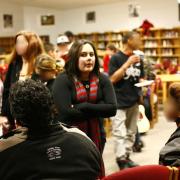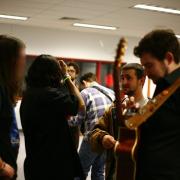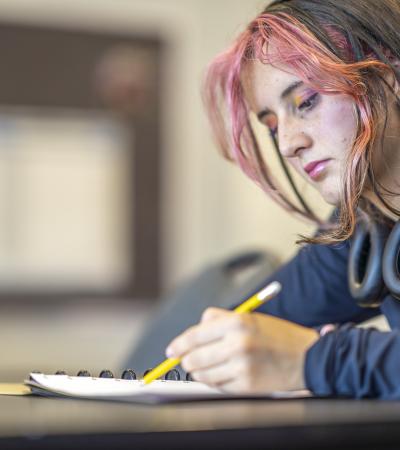Open Mic is a recurring event — open to students, staff and the community — typically hosted on either a Thursday or Friday night from 6 to 9 p.m. Students and staff are granted five minutes on stage for any school-appropriate performance. Performances have ranged from poetry readings (of students’ own works or from a favorite poet) to singing, dancing, comedians and even heavy metal bands. The event has drawn audiences of 8 to 120 people, including family to friends, even pets. Coffee and snacks are served.
Advanced Planning
I originally hosted an Open Mic to encourage “fringe” students to take part in something school-related. Many had talents to share, and I thought an Open Mic would be a great venue to share them. It really was a “see what the community needs and offer them an opportunity to do it” kind of moment. As a new librarian at a school that hadn’t used its facilities often before, I thought it was a great chance to let everyone know that the library was a "happening" place and that all were welcome.
The first few times we had Open Mic, it was a simple affair: we picked a date, cleared it on the calendar, and made a sign-in sheet. As the events gained in popularity and status, we had to do a bit more planning (for example, making sure it didn’t fall on a major sport, band or art night). We also had to clear more administrative hurdles as we realized security officers were needed for evening events. None of the new hurdles were showstoppers, and it was still pretty easy to put an event together with just a few weeks’ notice.
Marketing
When it first started, the Open Mic event was posted in the hallways with fliers and posted on the library doors. The sign-up sheet was located at the front desk of the library for a week before the event. The book was almost always full a few days before the program.
The best promotion was word of mouth. During the week or two leading up to Open Mic, students would often bring guitars or other instruments into the library to play and practice during lunch. The loud music coming from the library often brought even more students in, at least to see what was up! A lot of parents and community members who come to the event know at least one student who will be performing, and they spread the word to others. As our PTO (Parent Teacher Organization) grew and started a newsletter, upcoming Open Mics were announced in the newsletter.
Budgeting
The first few events were “out of pocket” – I’d purchase three or four bags of cookies and a few packs of Capri Suns. As time went on, I found a local Starbucks willing to donate a couple of Traveler packs of coffee (including decaf). Since the original Open Mics were such a community success, our fine arts department found $50 in the budget to begin supporting the program. A few times we didn't have any funding, and parents brought pot-luck snacks while the school provided waters. Popcorn and nachos were our cheapest snacks: a large bag of tortilla chips ($3) and a large can of cheese dip ($8) could reasonably provide a snack for a large number of people.
Day-of-event Activity
Students participated in setting up the stage for the performance, borrowing materials from our theater and laying wires for microphones, amps and other equipment. Some nights, the band teachers would bring a keyboard to accompany a singer. When we first started, there was one speaker and a microphone. By the third year, there were multiple amps, monitors and even a computer system that recorded the events for posting on YouTube!
Program Execution
Our first event had about 80 people in attendance, with the second bringing in over 110 people. This maxed out our performance area. The first Open Mic happened shortly after a “riot” on our campus (and all the bad publicity that comes with a fight at school). The publicity from Open Mic night helped put the school in a better light, so administration and the community both loved it. As we continued to host Open Mics, television and radio stations in the area got involved, filming and interviewing students about the event on the Social Justice Program.
In addition, one of the teachers who performed at Open Mics saw the students setting up the A/V and created a class, passed it through the curriculum council, and we now have a class designed to give students skills in broadcast journalism! I was originally hoping to increase usage of the library (I did: quadrupling the number of classes, students stopping in, and number of books checked out) but the events ended up doing so much more: creating classes, garnering local and national media coverage and even a chance to have students interviewed by college students at the University of Texas.
Advice
Go with what you know, find out what your library users, community or other groups might need, and see if you can get it to them. This is not meant to sound flippant, but it’s a classic guerilla marketing technique: how to get the best bang for the buck while getting the word out. I know and love music; I know some teens love music, or art, or comedy, or poetry; I know they feel more comfortable in small settings, and are willing to share if the vibe is right: supportive, encouraging. So I went with what I knew and provided an opportunity for the kids to perform in a safe setting, and I got a whole lot more back than I expected! It was definitely a win-win-win: for the library, the community, and most importantly, the students.
Supporting Materials
- Feedback (Coming Soon!)
- Programming Librarian Facebook Group





